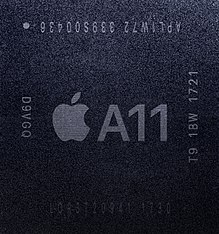Apple A11 Bionic
The Apple A11 Bionic is a single-chip system (SoC) from the US company Apple . The A11 Bionic was presented to the public on 12 September 2017 and comes in the iPhone 8 , iPhone 8 Plus and iPhone X used. Its predecessor is the A10 Fusion and its successor is the A12 Bionic .
technology
The A11 consists of a 64-bit ARMv8 -A CPU with six cores developed by Apple . Two of them are high-performance cores called "Monsoon", the other four are called "Mistral" and are energy efficient . In contrast to its predecessor, the A10 , the SoC can address all six cores simultaneously via a new performance controller. For the first time, an Apple SoC contains a graphics processor that was developed by the company itself. This has three cores and is 30% faster than that of the A10. A new motion coprocessor is also included with the M11 . The new image processor supports lighting estimation , wide color capture and advanced pixel processing . A neural engine for Face ID , Animoji and other machine learning tasks processes up to 600 billion operations per second. This means that calculations for the provision of artificial intelligence can be carried out directly on the smartphone instead of in the cloud , as was previously usually the case .
According to the Geekbench benchmark, the performance of the A11 is on the level of an Intel Core i7-7567U (dual core, 3.6 GHz, 28 W TDP ) in the MacBook Pro from 2017. In the Antutu benchmark, the A11 achieved 226,058 points and thus exceeded the first smartphone SoC to be the 200,000.
The chip is manufactured by TSMC using the 10 nm FinFET process and has 4.3 billion transistors. The SoC with the designation APL1W72 together with the LPDDR4X-RAM forms a PoP (Package-on-Package), manufactured using TSMC's InFO-Packaging process. There is a variant of the A11 with 2 GB of RAM , built into the iPhone 8, and a variant with 3 GB, built into the iPhone 8 Plus and iPhone X; the RAM is connected via a 64-bit bus . The The measures 87.7 mm, 41% smaller than that of A10.
Individual evidence
- ↑ a b Apple 2017: The iPhone X (Ten) Announced , AnandTech on September 12, 2017
- ↑ iOS 11 GM Leak Reveals Details on Face ID, Apple Pay, Wireless Charging, and A11 Chip in iPhone X , MacRumors on September 10, 2017
- ↑ The future is here: iPhone X , Apple on September 12, 2017
- ↑ iPhone 8 - Technical Specifications , Apple on September 12, 2017
- ↑ The iPhone X's new neural engine exemplifies Apple's approach to AI , The Verge on September 13, 2017
- ↑ Intel® Core ™ i7-7567U Processor (4M Cache, up to 4.00 GHz) Product Specifications. Retrieved August 1, 2019 .
- ↑ A11 Bionic Chip in iPhone 8 and iPhone X on Par With 13-Inch MacBook Pro, Outperforms iPad Pro , MacRumors on September 13, 2017
- ↑ Apple's A11 Bionic SoC Crosses 200k Antutu Barrier With Ease , wccftech on September 16, 2017
- ↑ Apple iPhone 8 Plus Teardown , TechInsights on October 3, 2017

